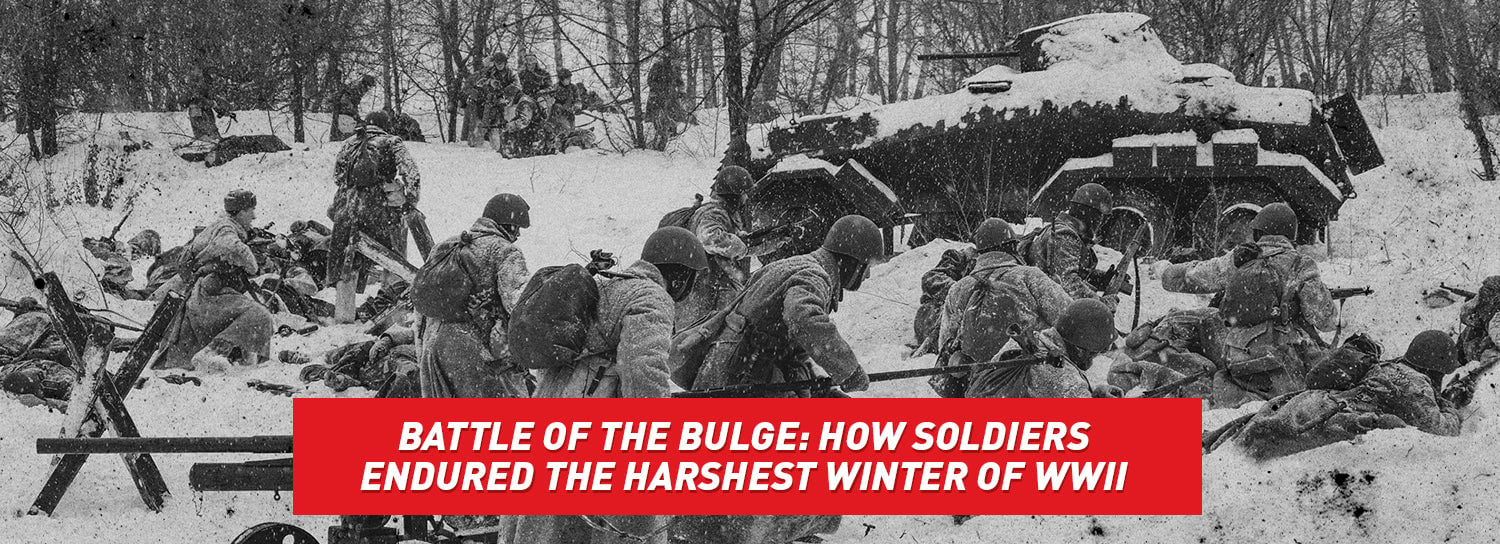
Winston Churchill called The Battle of the Bulge “the greatest American battle of the war.”
Fought from December 16, 1944, to January 25, 1945, it was not only the deadliest battle for the U.S. Army, but also a testament to the resilience and ingenuity of American troops.
In addition to the soldiers lost in the battle, many soldiers died due to the harsh conditions.
This was all part of Hitler’s plan.
According to the Best Defense Foundation:
Hitler’s plan hinged on exploiting a perceived weakness in the Ardennes, a region ill-suited for winter operations, where he anticipated a lack of Allied preparedness. […] The element of surprise, coupled with unfavorable weather conditions like fog and low clouds, was seen as crucial. Additionally, launching the attack in a situation where the Allied aviation couldn’t operate freely was deemed essential.
The attack took place when there were several inches of snow on the ground, and temperatures were well below freezing.
American troops were not prepared to fight harsh winter conditions, and the Germans used this to their advantage.
The History Channel explains:
As the battle raged, blizzards and freezing rain often reduced visibility to almost zero. Frost covered much of the soldiers’ equipment, and tanks had to be chiseled out of ice after they froze to the ground overnight. Many wounded soldiers froze to death before they were rescued, and thousands of American G.I.s were eventually treated for cases of frostbite and trench foot.
But the American troops did not give up.
Despite being caught off guard, they adapted quickly using survival techniques and defensive strategies to hold their ground.
Hitler’s Ardennes offensive, his last major attack of the war, ultimately crumbled against the Allies’ perseverance, marking a turning point in World War II.
Equipment and Gear Failures

Many of the Allies mistakenly expected WWII to be over by Christmas, but instead, they were fighting on Christmas Day in 1944.
With blizzards and fog, the Allies were unable to use their air support. However, it wasn’t easy to fight with the equipment on the ground, either.
Soldiers fought an uphill battle against their own gear.
Rifles jammed, vehicles froze, and tanks became immobilized by icy conditions. Even their boots were a problem—leather-soled footwear absorbed snowmelt, leading to trench foot and amputations.
Adaptability became key. Soldiers repaired gear with scavenged German parts and improvised insulation using anything they could find.
Getting Food and Medical Supplies
The weather and terrain made it difficult for food and medical supplies to be brought in for the troops.
With supply lines cut off, American troops survived on C rations. Even then, they still needed to ration supplies. These C rations, often frozen solid, had to be thawed over open flames.
When supplies ran out, some soldiers boiled pine needles for vitamin C or scavenged frozen horse meat from fallen cavalry units.
Improvising Solutions

During the battle, soldiers had to improvise.
For example, in the freezing temperatures, soldiers discovered their guns didn’t work.
PBS shared this from a GI: “The bolt would freeze on our machine guns. We remedied that by urinating on them just before we fired them.”
When faced with life or death, you have to think on your feet and use what you have—even if it makes you squeamish.
Defensive Strategies
One of the winning strategies the Allies employed was preventing the Nazis from accessing much-needed fuel reserves.
The History Channel explains:
The Nazi high command built their battle plans around capturing American fuel depots during their advance. Allied forces evacuated or burned millions of gallons of gas to prevent it falling into enemy hands, however, and by Christmas many German tank units were running on fumes. With no way to continue the advance across the Meuse River, the counterattack soon crumbled.
Soldiers sacrificed gas to prevent their enemies from using it against them.
[Related Read: Lessons from the WWII Ghost Army: How to Protect Your Home with Decoy Tactics]
Smart Thinking
During the Battle of the Bulge, the Germans aimed to create chaos.
One way they did so was by sending English-speaking German soldiers dressed in American uniforms behind U.S. lines.
When the U.S. troops figured out what was happening, they started to ask suspected Germans American trivia questions to prove their citizenship.
Gen. Omar Bradley recalled:
Three times I was ordered to prove my identity. […] The first time by identifying Springfield as the capital of Illinois; the second by locating the guard between the center and the tackle on a line of scrimmage; the third time by naming the then-current spouse of a blonde named Betty Grable.
Survival Tactics We Can Use Today

Remembering the Battle of the Bulge can help us prepare for extreme situations, too. Here’s how:
- Prepare for harsh conditions. The freezing temperatures at the Battle of the Bulge show how fast exposure can kill. Invest in insulated clothing, portable heating options, and thermal blankets. When heading outdoors, always pack for extreme temperatures. Keep thermal blankets in your car just in case you get stranded.
- Adapt gear for emergencies. Improvised solutions saved lives during the battle. Keep tools like duct tape, versatile multi-tools, and waterproof bags in your kit. They’re lifesavers when standard gear fails.
- Have additional heat sources. Many soldiers died or lost limbs due to the extreme winter weather. Hypothermia and frostbite continue to disable Americans today. Don’t let a power outage keep you in the cold. Invest in the VESTA Self-Powered Indoor Space Heater & Stove.
- Stock up on emergency food. Soldiers survived on C rations. Today’s emergency food is much tastier and fortified with essential vitamins and minerals. Stock up on long-term emergency food.
- Outsmart the enemy: The U.S. troops turned misinformation into a weapon, asking trivia questions to root out imposters. In today’s age of misinformation, critical thinking and reliable sources are your best defense. Ask the right questions to find the truth.
Learn from history, friends.
In liberty,
Elizabeth Anderson
Preparedness Advisor, My Patriot Supply


